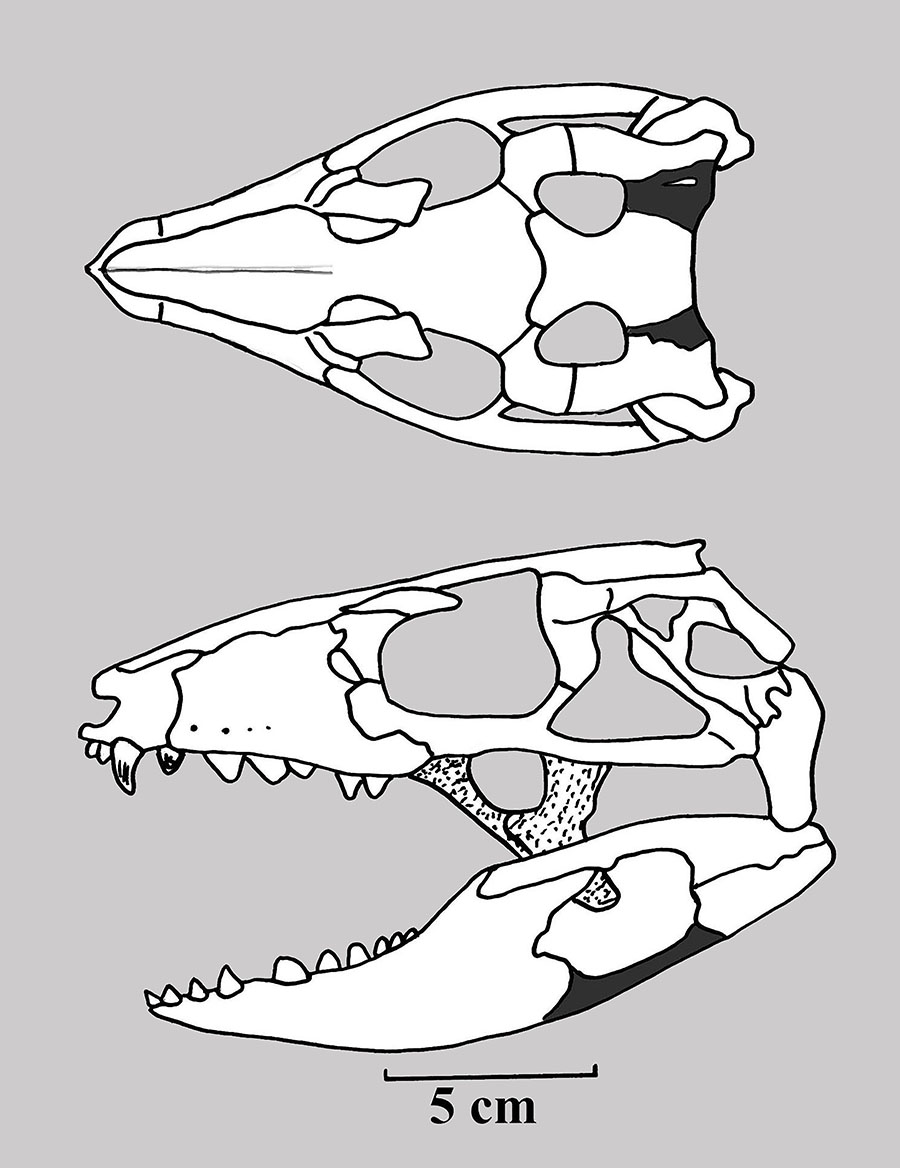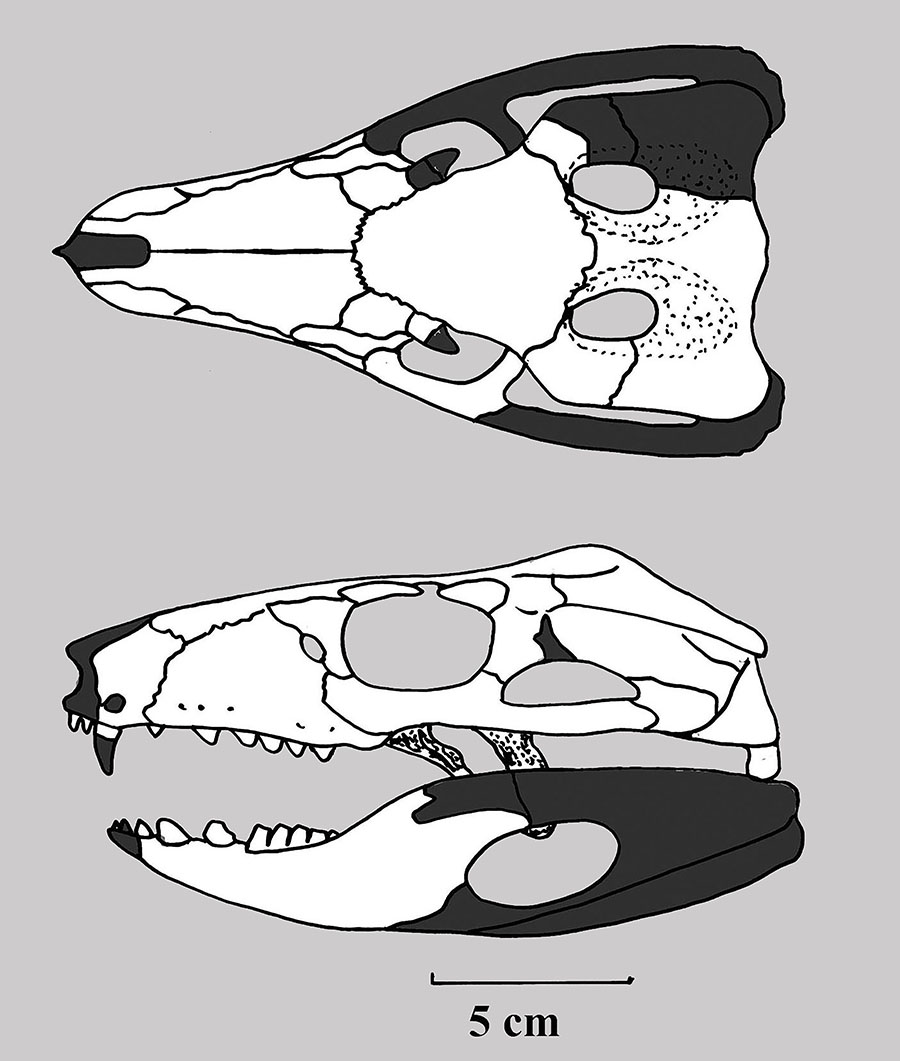
Genus: Caipirasuchus IORI & CARVALHO, 2011 (published 2012)
Etymology: The generic name Caipirasuchus is derived from the terms 'Caipira'
and Greek, souchus,"crocodile"; Caipira was what the indigenous people of
the countryside of Sao Paulo State called the first settlers of the region.
Today, the term refers to the rurual inhabitants of the BRazilian states, being
in widespread use in the State of Sao Paulo and some regions of the neighboring
states, covering almost all of the Bauru Basin.
Species: paulistanus IORI & CARVALHO, 2011 (published 2012)
Etymology: The specific name paulistanus is derived from 'paulista,' the designation
for the residens of Sao paulo Site, where the specimen was discovered.
Holotype: MPMA 67-0001/00
Locality: 6 km from Monte Alto, on the Sao Francisco Farm, 21°13'15.5"S, 48°30'41.6"W, Homen de Mello, the rual area of Monte Alto County, Sao Paulo State, Southeast Brazil.
Horizon: Adamantina Formation, Bauru Group.
Biostrtaigraphy:
Age: Turonian Stage, Uppermost Gallic Subepoch-Santonian Stage, Lower Senonian Subepoch, Lower Gulf Epoch, Late Cretaceous.
Material: Skull and mandible.

Caipirasuchus paulistanus (after Iori & Carvalho, 2011).
_____________________________________________________________________________________
Speices: montealtensis (ANDRADE & BERTINI, 2008) POL, NASCIMENTO,
CARVALHO, RICCOMINI, PIRES-DOMINGUES & ZAHER, 2014
= Sphagesaurus montealtensis ANDRADE & BERTINI, 2008
Etymology: The specific name after the City of Monte Alto, with a high number
of fossil sites from the Adamantina and Marilia Formations, one of them the
type-locality for this species.
= Sphagesaurus Nova ANDRADE & BERTINI, 2007
Holotype: MPMA-15/001-90
Locality: Bairro Cachoeira, locality at the base of the Serra da Agua Limpa, about 8 km northwest of the city of Monte Alto, Northern Sao Paulo State, Southeastern Brazil.
Horizon: Adamantina Formation, Bauru Group.
Biostratigraphy:
Age: Upper Campanian Stage- Lower Maastrichtian Stage, Senonian subepoch, Upper Gulf Epoch, Late Cretaceous.
Material: Skull.
Paratype: MMA-68.003/12: Fragmentary skull.

Caipirasuchus montealtensis (after Iori & Carvalho, 2011).
Referred material:
DIAS, LORI, GHILARDI & FERNANDES, 2020 (published 2019)
MPMA-68.0003/12: Fragmentary skull.
MPMA-68.0004/12: Fragmentary skull of a juvenile.
_____________________________________________________________________________________
Species: stenognathus POL, NASCIMENTO,
CARVALHO, RICCOMINI, PIRES-DOMINGUES & ZAHER, 2014
Etymology: Greek, stenos, 'narrow', and Greek, gnathos, 'jaw'; in reference
to thenarrow anterior portion of the mandible.
Holotype: MZSP-PV 139
Locality: Outcrop at Boa Esperanca farm, Prudencio de Moraes District, General Salgado City, General Salgado Municipality, San Paulo State, Brazil.
Horizon: Adamantina Formation, Bauru Group.
Biostratigraphy:
Age: Coniacian Stage?, Lower Senonian Subepoch, Lower Gulf Epoch, Late Cretaceous.
Material: Almost complete skull, lacking posterior left region and part of
the occipital region, found in articulation with complete lower jaws.

Caipirasuchus stenognathus (modified from Pol et al. 2014).
_____________________________________________________________________________________
Speices:
attenboroughi RUIZ, BRONZATI, FERREIRA, MARTINS, QUEIROZ, LANGER & MONTEFELTRO, 2021
Etymology: In honor of Sir David Attenborough, a palaeontology enthuisast and fossil collectore who sparked in many minds, including the first author of this study, an interest in life on Earth both past and present.
Holotype: LAPEISA-0001
Locality: A roadside outcrop at 111 km on SP-463 highway, 20°36'9.88"S, 50°30'50.19"W, General Salgado Municipality, north-western Sao Paulo State, Brazil.
Horizon: Santo Anastacio Formation, Caiua Group.
Biostratigraphy:
Age: Possibly Turonian Stage, Late Gallic Subepoch, Early Gulf Epoch, Middle Cretaceous-Campanian Stage, Senonian Subepoch, Gulf Epoch, Late Cretaceous.
Material: Part of the secondary palate, neurocranium and an almost complete lower jaw with 9 partially preserved tooth crowns.